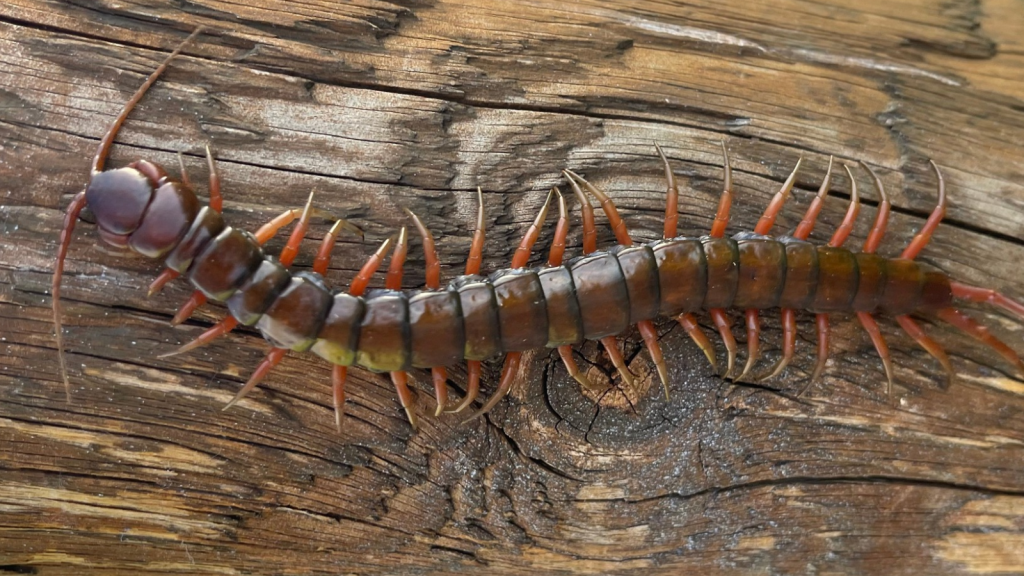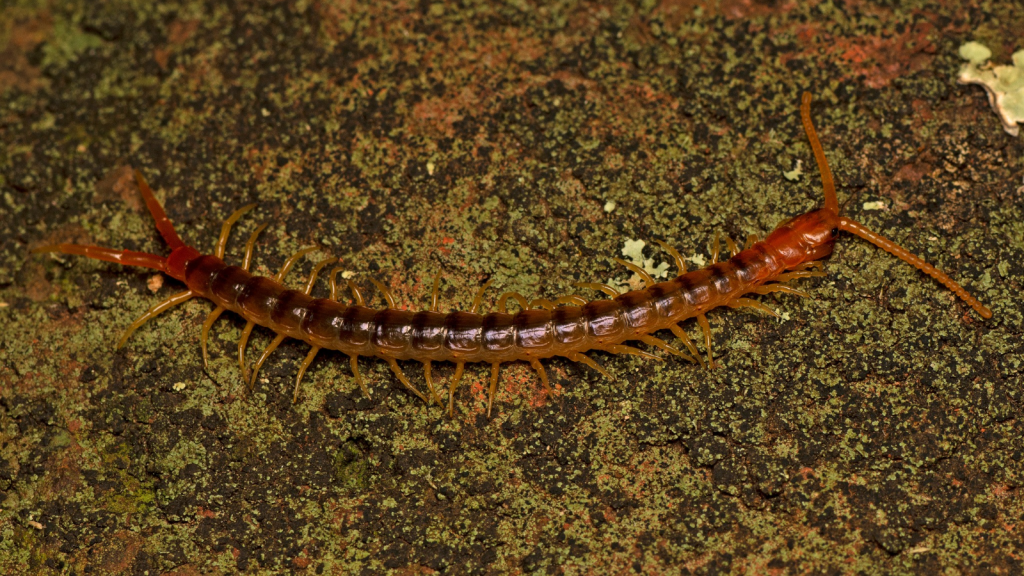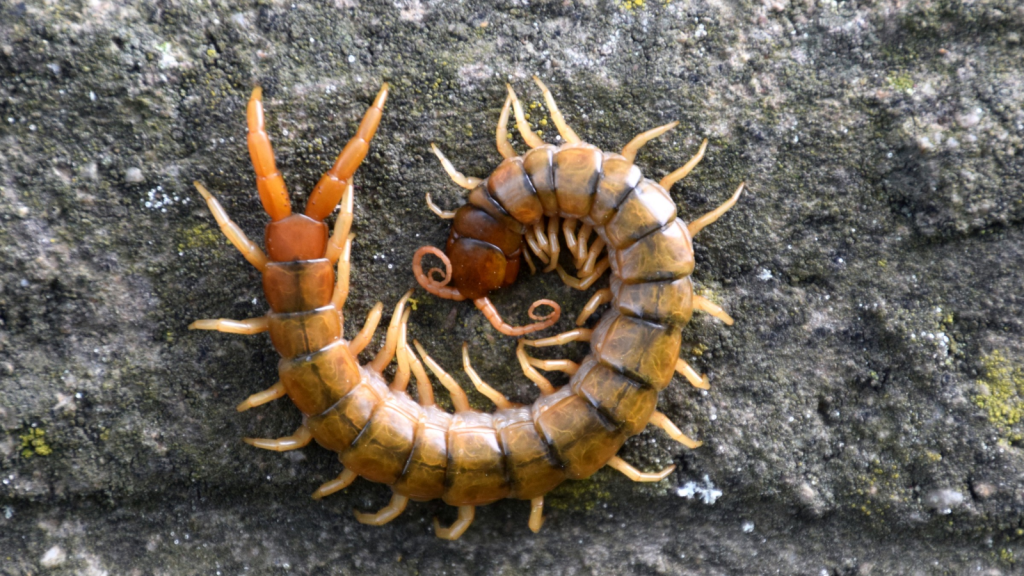Centipedes are fascinating creatures that have roamed the Earth for over 400 million years. With their numerous legs and swift movements, these arthropods have adapted to various environments across the globe. While most centipedes are harmless to humans, some species can pack a painful punch with their venomous bite. From the giant Amazonian centipede to the tiny house centipede, these segmented invertebrates come in a startling array of shapes, sizes, and colours. Join us as we explore 18 centipedes that might just keep you up at night – if you’re not too busy running away from them!
Giant Amazonian Centipede

The Giant Amazonian Centipede is a true monster of the arthropod world. Growing up to 30 centimetres long, this beast is the largest centipede species on Earth. Its powerful venom can take down prey much larger than itself, including birds, lizards, and even small mammals. These centipedes are excellent swimmers and have been known to hunt fish in shallow waters.
Scolopendra Subspinipes

Also known as the Chinese Red-Headed Centipede, this species is notorious for its aggressive behaviour. Its bite is extremely painful and can cause severe swelling, fever, and weakness in humans. These centipedes are common in many parts of Asia and have even been found in the London Underground! They’re highly adaptable and can thrive in urban environments, often hiding in dark, damp spaces.
House Centipede

Don’t let its small size fool you – the House Centipede is a lightning-fast predator. With 15 pairs of legs, it can sprint at speeds of up to 40 centimetres per second. While it’s harmless to humans, this centipede is a fearsome hunter of household pests like cockroaches and silverfish. House centipedes are beneficial to have around, as they help control populations of more problematic insects in your home.
Vietnamese Giant Centipede

This striking blue-legged centipede is a sight to behold. Growing up to 20 centimetres long, it’s one of the largest centipedes in Southeast Asia. Its powerful venom can cause excruciating pain and even temporary paralysis in humans. These centipedes are nocturnal hunters, using their sensitive antennae to locate prey in the dark.
Arizona Tiger Centipede

Named for its distinctive tiger-like stripes, this centipede is a common sight in the southwestern United States. It’s known for its painful bite, which can cause severe discomfort for several hours. Despite its fearsome reputation, it plays a crucial role in controlling insect populations in desert ecosystems. The Arizona Tiger Centipede is well-adapted to arid conditions and can survive long periods without water.
Giant African Yellow Leg Centipede

This impressive centipede can grow up to 25 centimetres long and sports bright yellow legs. Native to East Africa, it’s known for its powerful venom and aggressive behaviour. Its bite can cause intense pain, swelling, and in rare cases, more serious symptoms like fever and nausea. These centipedes are often kept as exotic pets, but their care requires expertise and caution.
Peruvian Giant Yellow-Leg Centipede

This South American giant is closely related to the Amazonian centipede. With its striking yellow legs and dark body, it’s a visually intimidating predator. Its venom is potent enough to quickly immobilise large insects and small vertebrates. These centipedes are known to be cannibalistic, sometimes preying on smaller members of their own species.
Japanese Okinawa Centipede

Found on the islands of Okinawa and Taiwan, this centipede is known for its beautiful blue-green colouration. Despite its attractive appearance, it’s one of the most venomous centipedes in Japan. Its bite can cause severe pain and swelling that may last for several days. The Okinawa Centipede has a unique defence mechanism – it can detach its legs to escape predators, similar to how some lizards can shed their tails.
Stone Centipede

The Stone Centipede is a common sight in gardens across Britain. Unlike many of its more intimidating cousins, this species is relatively small and harmless to humans. It’s an important predator of garden pests, helping to keep slug and snail populations in check. Stone Centipedes are excellent climbers and can often be found scaling walls and trees in search of prey.
Mediterranean Banded Centipede

This striking centipede is easily recognised by its alternating bands of black and yellow-orange. Common in southern Europe and North Africa, it’s known for its painful bite. While not dangerous to humans, its venom can cause significant discomfort and swelling. These centipedes are well-adapted to hot, dry climates and can often be found hiding under rocks or in leaf litter during the day.
Australian Giant Centipede

The Australian Giant Centipede is one of the largest centipedes in the world, reaching lengths of up to 25 centimetres. Its potent venom can cause intense pain, swelling, and in rare cases, more serious symptoms. Despite its fearsome reputation, it plays an important role in controlling insect populations in the Australian bush. These centipedes are known for their exceptional climbing abilities and can often be found high up in trees.
Blue Ring Centipede

This beautiful centipede is native to Southeast Asia. Its body is adorned with striking blue rings, making it one of the most visually appealing centipedes. However, its beauty belies its potent venom, which can cause severe pain and swelling in humans. The Blue Ring Centipede is primarily arboreal, spending much of its time in trees and shrubs.
European Yellow-Tailed Centipede

Common across much of Europe, this centipede is easily identified by its yellow-tipped legs. While not as large or venomous as some of its tropical cousins, its bite can still be quite painful. It’s an important predator in European woodlands, helping to control populations of smaller invertebrates. These centipedes are known for their longevity, with some individuals living up to six years in captivity.
Indian Tiger Centipede

This striking centipede is found across the Indian subcontinent. Its body is marked with distinctive tiger-like stripes, giving it its common name. While its venom is not particularly dangerous to humans, its bite can cause significant pain and swelling. The Indian Tiger Centipede is known for its speed and agility, able to quickly navigate through leaf litter and dense vegetation.
Hawaiian Centipede

The Hawaiian Centipede, or Scolopendra subspinipes, is one of the largest invertebrates native to the Hawaiian islands. Growing up to 20 centimetres long, it’s known for its painful bite and aggressive behaviour. Despite its fearsome reputation, it plays an important role in Hawaii’s fragile island ecosystems. These centipedes are excellent swimmers and have been known to hunt in both freshwater and marine environments.
Cuban Blue Centipede

This beautiful centipede is found only on the island of Cuba. Its body is a striking metallic blue colour, making it one of the most visually stunning centipedes in the world. While its venom is not particularly dangerous to humans, its bite can still be quite painful. The Cuban Blue Centipede is primarily nocturnal, hiding in dark, damp places during the day and emerging at night to hunt.
Red-Headed Centipede

The Red-Headed Centipede is found across much of the southern United States. As its name suggests, it has a distinctive red head and legs, contrasting with its dark body. Its bite is known to be extremely painful, causing intense burning sensations that can last for several hours. These centipedes are known for their aggression and will not hesitate to defend themselves if threatened.
Greek Centipede

The Greek Centipede is a common sight in the Mediterranean region. While not as large or venomous as some tropical species, it’s still a formidable predator in its own right. Its bite can cause significant pain and swelling in humans, but it’s generally not considered dangerous. These centipedes play a crucial role in Mediterranean ecosystems, helping to control populations of insects and other small invertebrates.
15 Animals That Eat Hornets

Nature never fails to amaze me. Who would’ve thought so many creatures would prey on hornets? Their painful stings and fierce and aggressive behaviour make them seem like a pretty unappetizing meal to me. While hornets might seem like formidable insects that few creatures would dare to tangle with, they actually have quite a few natural enemies. From nimble birds to crafty mammals, plenty of other creatures make meals out of these stinging insects.
Read More: 15 Animals That Eat Hornets
Meet the Wolf Spider | One of Britain’s Biggest Spiders

Wolf spiders are a remarkable group of arachnids found across the UK and around the world. These agile hunters get their name from their wolf-like hunting style, actively chasing down prey rather than spinning webs. With their large eyes and hairy bodies, wolf spiders might look intimidating, but they’re actually quite beneficial to gardens and homes. These spiders help control pest populations and are generally harmless to humans. From their unique parenting techniques to their impressive hunting skills, wolf spiders are full of surprises.
Read More: Meet the Wolf Spider | One of Britain’s Biggest Spiders
Becky is a fervent wildlife enthusiast and pet care expert with a diploma in canine nutrition. Her love for animals stretches beyond the domestic, embracing the wild tapestry of global fauna. With over a decade of experience in animal welfare, Becky lends her expertise to OutlandishOwl through insightful articles, captivating wildlife information, and invaluable guidance on pet nutrition. Her work embodies a deep commitment to understanding the intricate lives of animals and a passion for educating others on sustaining natural habitats. Becky's hands-on conservation efforts and her knack for translating complex dietary science into practical pet feeding tips make her an indispensable voice for creatures great and small.




